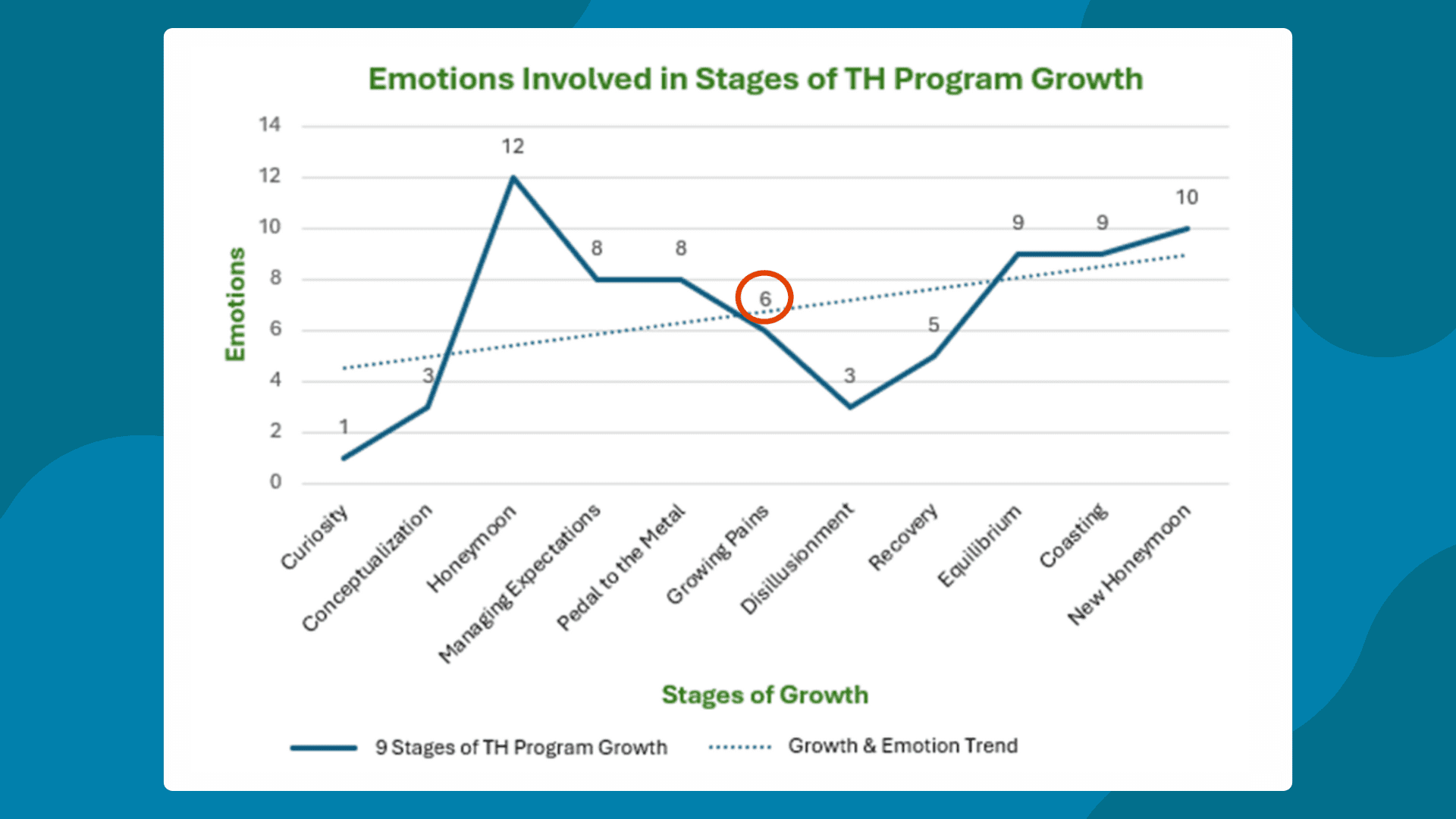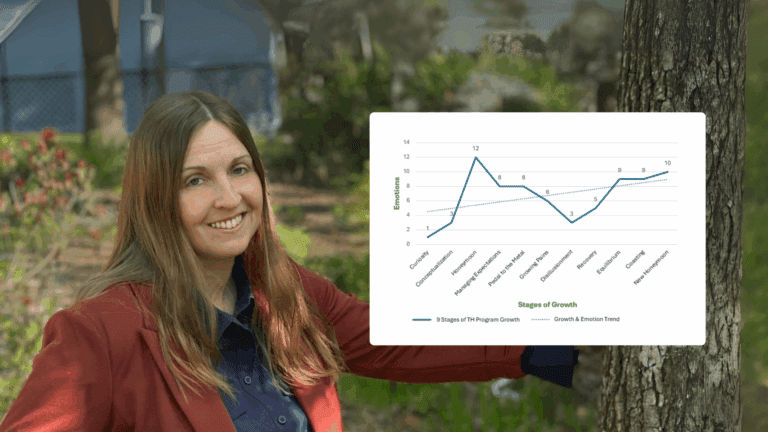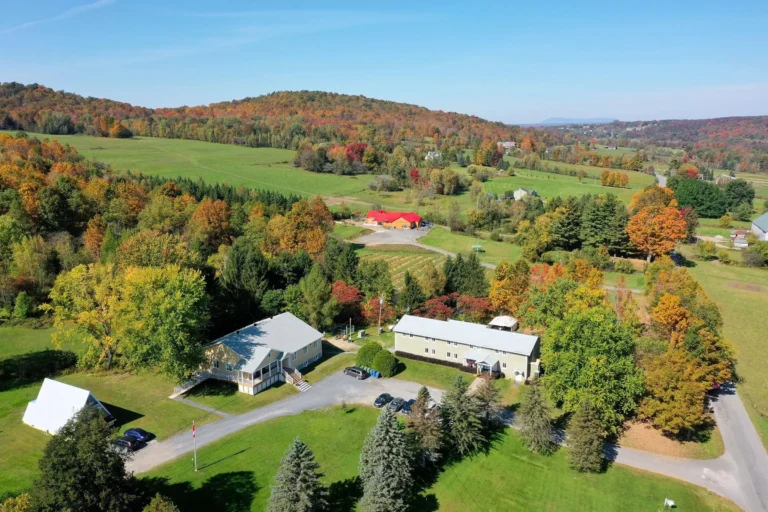Starting a therapeutic horticulture (TH) program can feel like planting seeds in unfamiliar soil – filled with anticipation, hope, and, let’s be honest, a fair amount of uncertainty. Whether you’re developing a new initiative in a long-term care home, school, community space, or healthcare setting, most practitioners discover that the journey follows a set of recognizable emotional and operational stages.
I’ve seen it time and again: programs flourish when practitioners understand that the growth process is cyclical and very human. Recognizing these stages gives you language for the ups and downs and helps you approach your work with more resilience, patience, and confidence.
Table of Contents
Stage One: Curiosity
It begins with a spark. Maybe you’ve noticed your participants light up when they’re near plants. Maybe you’ve read about the evidence base for therapeutic horticulture or already have training in TH or HT. At this stage, you (or your site) are simply asking the question: “Could TH work here?”
🌱 Imagine an activity director who notices a resident perk up while watering a houseplant. The wheels start turning: What if gardening could be more than a passing moment of joy? What if it became part of their therapeutic plan?
Stage Two: Conceptulization
Ideas start to take root. You begin dreaming, assessing your site, and having early conversations with staff and leadership. This is where the seeds of collaboration are planted and relationships start to form.
🌱 Picture a practitioner sketching out garden layouts during their lunch break, or presenting the idea of raised beds at a team meeting. The concept may still be rough, but there’s excitement in the air—and early buy-in makes a huge difference.
Stage Three: Honeymoon
Enthusiasm is high, plans are coming together, and the possibilities feel endless. Promises are exchanged, and both practitioner and site administrators are sketching out a program budget with optimism. Clients and participants often mirror this anticipatory excitement, making it a joyful stage. Savor this energy; it’s fuel for the harder days ahead.
🌱 Picture site administrators drafting projections of promising treatment outcomes, or brainstorming the splashy headlines of a future public relations campaign. Picture the practitioner reworking their schedule, imagining fewer traditional duties and more time devoted to TH sessions—maybe even with the hint of a pay increase on the horizon. The vision feels bright, and everyone is leaning into what could be.

Stage Four: Managing Expectations
This stage is often skipped, but it’s critical. By clarifying roles, setting realistic timelines, and discussing budget constraints, you can prevent misunderstandings down the road. Boundaries and communication are what transform early excitement into sustainable momentum.
🌱 A rehabilitation center team discovers that not every staff member has time to water plants daily. By naming this limitation and building a care schedule, the program avoids frustration and burnout. Clear expectations create smoother progress later.
Stage Five: Pedal to the Metal
Now you’re all in. You’re facilitating sessions, juggling logistics, and adapting on the fly. It’s rewarding, but exhausting. The risk of burnout is real. Support systems, self-care, and streamlined processes are your lifelines here.
🌱 Picture a practitioner rushing from group sessions to the garden to check irrigation, all while managing participant needs, and their traditional work duties. The pace is exhilarating but also draining. Without proper boundaries, the practitioner risks running on empty.
Stage Six: Growing Pains
Challenges emerge: resource shortages, staff turnover, broken promises, or participant needs you didn’t anticipate. Remember: this isn’t failure. It’s a natural stage of program growth, calling for reflection, problem-solving, and collaborative creativity.
🌱 Consider a community garden where funding falls through mid-season. The practitioner feels stuck, but by rallying volunteers, seeking donations, and adjusting expectations, the program survives and even finds new strength.
Stage Seven: Disillusionment
This stage can feel like the lowest valley. Support wanes, doubts creep in, and the shine of those early days has faded. But here’s the truth: this stage can be a turning point, it doesn’t need to be an endpoint. If you acknowledge it, you can pivot, reconnect with your purpose, and move forward. This is where the practitioner’s resilience really comes into play..
🌱 An activity manager wonders if all the effort is worth it when only a few participants show up and the promise of a possible pay raise hasn’t materialized yet. The disappointment is real, but by re-engaging staff allies and rethinking activity timing, participation slowly increases again.
Stage Eight: Recovery
Some programs regroup and adapt. Others evolve into something new or even conclude. This stage is about evaluation and strong communication skills—figuring out what’s working, what’s not, and giving yourself permission to adjust course with the accurate information no one could have anticipated in the conceptualization stage. Often, programs mature in unexpected and deeply meaningful ways here.
🌱 A practitioner in a hospital realizes outdoor gardening is too logistically difficult. Instead, they shift to an indoor plant cart program, which turns out to be more engaging and accessible for clients than the original idea.
Stage Nine: Equilibrium
With time and persistence, your program finds its rhythm. Systems are in place, roles are clear, and participants are benefitting in sustainable ways. This is worth celebrating – a marker of growth that lays the foundation for continued evolution and collaboration with the site.
🌱 Think of a senior living community where weekly gardening sessions become as routine as bingo. Residents look forward to it, staff know their roles, and the program feels stable and sustainable. This is the sweet spot of therapeutic horticulture.

Cycles of Growth
Even after you’ve reached equilibrium, new growth cycles will always emerge—whether that’s scaling your capacity or reaching new communities. The good news? Each cycle becomes easier. With experience comes resilience, and what once felt overwhelming begins to feel natural.
Why Mapping the Stages Matters
The emotional arc of these nine stages is real. It helps explain why programs sometimes stall, why practitioners doubt themselves, and why the process can feel like a rollercoaster. By naming the stages, you can move through the highs and lows with more understanding and less self-judgment—bringing a sense of grounding and comfort.
Therapeutic horticulture isn’t just about cultivating gardens. It’s also about navigating the emotional landscape of building and sustaining programs that truly make an impact. Whether you’re just planting the first seed of an idea or working to sustain an existing program, understanding these stages can provide clarity, validation, and confidence.
🌱 Watch the full session recording here
In this talk, I share candid lessons from my own experience and practical tools to help practitioners, program leads, and organizations at any stage of the journey. It’s an honest, encouraging conversation about the paradox of joy and disillusionment in this field, and how you can cultivate the confidence, resilience, and sense of purpose you deserve.

Emilee Weaver
Director of Learning & Community Engagement





